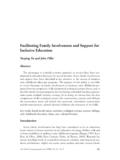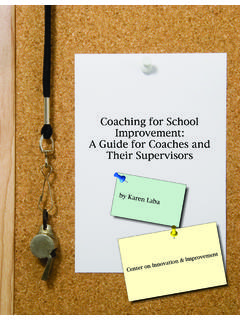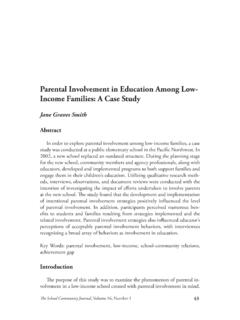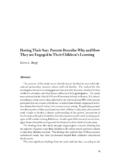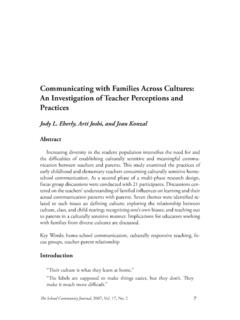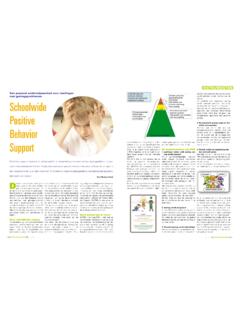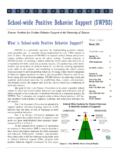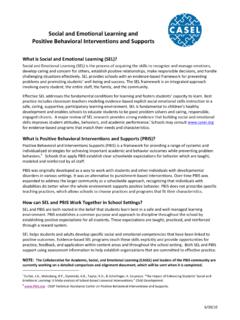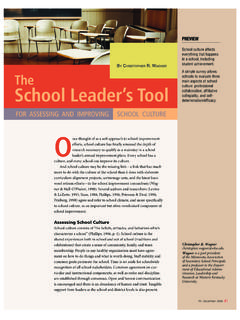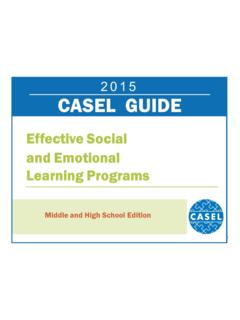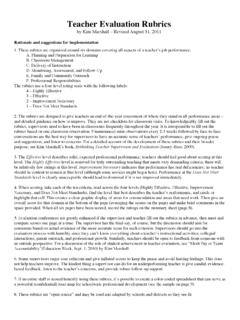Transcription of Spring/Summer 2018 Volume 28, Number 1 - adi.org
1 Fall/Winter 2017 Volume 27, Number 2 Academic Development InstitutePaul J. BakerIllinois State University (Emeritus)Normal, IllinoisAlison A. Carr-ChellmanUniversity of IdahoMoscow, IdahoJames P. Comer Yale Child Study CenterNew Haven, ConnecticutRollande DeslandesUniversite du Quebec a Trois-RivieresQuebec, CanadaPatricia EdwardsMichigan State UniversityEast Lansing, MichiganJoyce L. EpsteinCenter on School, Family & Community PartnershipsJohns Hopkins University Baltimore, MarylandPatricia G ndara UCLA Graduate School of EducationLos Angeles, CaliforniaRaquel-Amaya Mart nez Gonz lez Universidad de OviedoOviedo, SpainAnne T. HendersonAnnenberg Institute for School ReformWashington, Sui-Chu HoThe Chinese University of Hong KongHong Kong SAR, ChinaKathleen V. Hoover-DempseyPeabody College at Vanderbilt UniversityNashville, TennesseeWilliam H. JeynesCalifornia State University, Long BeachWitherspoon InstitutePrinceton, New JerseyArti JoshiThe College of New JerseyEwing, New JerseyHazel Loucks National Education AssociationEdwardsville, IllinoisKaren L.
2 MappHarvard Graduate School of EducationCambridge, MassachusettsDenise MaybankMichigan State UniversityEast Lansing, MichiganToni Moynihan-McCoyCorpus Christi Independent School DistrictCorpus Christi, TexasEva PatrikakouDePaul University Chicago, IllinoisJanice M. RosalesEducational ConsultantVilla Park, IllinoisLoizos SymeouEuropean University-CyprusNicosia, CyprusHerbert J. WalbergHoover Institution at Stanford UniversityChicago, IllinoisHeather WeissGlobal Family Research ProjectBoston, MassachusettsRoger WeissbergUniversity of Illinois at ChicagoChicago, IllinoisSchool Community JournalFall/Winter 2017 Volume 27, Number 2 School Community Journal Advisory BoardSam Redding, Executive EditorLori G. Thomas, EditorTHE SCHOOL COMMUNITY JOURNALFall/Winter 2017 Volume 27, Number 2 Academic Development InstituteISSN 1059-308X 2017 Academic Development InstituteBusiness and Editorial OfficeSchool Community Journal121 N. Kickapoo StreetLincoln, IL 62656 USAP hone: 217-732-6462 Fax: 217-732-3696 Email: for ManuscriptsSchool Community Journal publishes a mix of: (1) research (original, review, and interpreta-tion), (2) essay and discussion, (3) reports from the field, including descriptions of programs, and (4) book reviews.
3 The journal seeks manuscripts from scholars, administrators, teachers, school board members, parents, and others interested in the school as a Policy and ProcedureSchool Community Journal is committed to scholarly inquiry, discussion, and reportage of topics related to the community of the school. Manuscripts are considered in the four catego-ries listed : The journal generally follows the format of the APA Publication Manual, 6th Edition; we prefer direct links whenever possible to online sources in the reference list. Please make sure electronic links cited are accurate and active. Use italics rather than underlining. Do not use tabs to format paragraphs or tables; please use the Insert Table function for tables and the First Line Indent function for paragraphs. Color for tables or figures is should send the following to via email attachments (in Word): 1. The blinded manuscript, including an abstract of no more than 250 words in the same file, plus any tables or figures; 2.
4 A one paragraph description (each) of the author(s) and a mailing address, phone Number , and email address where each author can be reached The accompanying email cover letter should state that the work is not under simultaneous con-sideration by other publication sources. A hard copy of the manuscript is not necessary unless specifically requested by the editor. As a refereed journal, all submissions undergo a blind peer review as part of the selection process. Therefore, please include the author s description and other identifying information in a separate electronic file. Further submission instructions may be accessed on our website: to the School Community JournalSchool Community Journal has been published twice annually since 1991 Spring/Summer and Fall/Winter. School Community Journal is now a free, open access, online-only publication. Therefore, we are no longer accepting subscriptions. If you would like to receive a free email notice when new journal issues are posted online, contact and ask to be added to journal notices.
5 Please include your mailing address, also. The archives of the journal may be accessed (free) at s G. ThomasTheoretical and Conceptual Frameworks Used in Family School PartnershipsLois A. Yamauchi, Eva Ponte, Katherine T. Ratliffe, and Kevin TraynorDiverse Asian American Families and Communities: Culture,..35 Structure, and Education (Part 1: Why They Differ)Susan J. Paik, Zaynah Rahman, Stacy M. Kula,L. Erika Saito, and Matthew A. WitensteinEthnic Afterschool Programs and Language Schools in American Communities: Varying Resources, Opportunities,and Educational Experiences (Part 2: How They Differ)Susan J. Paik, Zaynah Rahman, Stacy M. Kula,L. Erika Saito, and Matthew A. WitensteinTraversing School Community Partnerships LeadershipBernita L. Krumm and Katherine CurryInclusive Prekindergarten Classrooms in a New Era: Perspectives of Teachers in the United StatesElizabeth McKendry Anderson and Karen Wise LindemanUnderstanding Family Engagement Through the Focus of Standards for Family School Partnerships: SecondaryPreservice Teachers PerspectivesMargaret M.
6 FerraraEngaging Families at the Secondary Level: An for Student SuccessKrista L. Jensen and Kathleen M. MinkeContents continued next pageSCHOOL COMMUNITY JOURNAL6 Middle School Students Perceptions Regarding and Effectiveness of HomeworkKathleen G. Burriss and Donald SneadContext of Latino Students Family Separation During Immigration: Perspectives, Challenges, and Opportunitiesfor Collaborative EffortsJeremiah J. Gonz lez, Stacy M. Kula, Ver nica V. Gonz lez, and Susan J. PaikImpact of Latino Parent Engagement on Student : A Pilot StudyJuan Carlos Araque, Cathy Wietstock, Heather M. Cova, and Steffanie ZepedaThe Role of Skills-Based Interventions and Settings on of Diverse FamiliesYvette LatundeMeasuring Parent Perceptions of Family School Engagement:..275 The Development of New Survey ToolsBeth E. Schueler, Joseph C. McIntyre, and Hunter GehlbachSchool Climate Community Scale: Report on and Internal ConsistencyAmrit Thapa and Jonathan CohenBook Review of Parents Matter: Supporting Your Math in Grades K 8 Nancy GoldbergerEditor s CommentsWe have another full issue to help our readers collaborate and build healthy school communities!
7 Our first article, from Yamauchi, Ponte, Ratliffe, and Traynor, examines the theories and frameworks used in research on family school partnerships and serves as a call for better and more consistent practices in future research. Next we have a pair of articles from Paik, Rahman, Kula, Saito, and Witenstein, who provide a useful look at various Asian American subgroups and their respective characteristics and ethnic social structures which help provide social capital for students and families in these communities. Krumm and Curry study school community partnerships by interview-ing school administrators utilizing cross-boundary leadership. Anderson and Lindeman talk with general and special education teachers collaborating in inclusive prekindergarten classes, uncovering both benefits and challenges. Ex-amining secondary preservice teachers perspectives, Ferrara reveals insights from an online course on family engagement.
8 Jensen and Minke are also con-cerned with engaging families of students in secondary schools, providing an in-depth literature review and implications for practice and future research. Burris and Snead, however, look at the students point of view, questioning middle schoolers about lez and his colleagues address the need for awareness and collabora-tion to support immigrant students who are experiencing (or have experienced) separation from family members. Araque, Wietstock, Cova, and Zepeda inves-tigate the effects of a series of workshops for Latino families on the academic achievement of their children. Latunde also examines the impact of workshops for families, focusing on the differences for diverse families when the trainings are offered in various , we have two articles regarding the development of surveys. Schuel-er, McIntyre, and Gehlbach report on the development of surveys to measure school-based family engagement and the barriers to such engagement.
9 Mean-while, Thapa and Cohen test the School Climate Community Scale which has been used by students to query community members and increase collabo-ration for school improvement. We round out this issue with a book review by Goldberger of Parents Matter: Supporting Your Child with Math in Grades K reading!Lori G. ThomasDecember 2017 Editorial Review BoardJeffrey A. AndersonIndiana University, BloomingtonJi-Hi BaeSungshin Women s University, Seoul, KoreaPamela Hudson BakerGeorge Mason University, Fairfax, VABrian R. BeaboutUniversity of New Orleans, LAPhilip E. BernhardtUniversity of Denver, COMichael L. Boucher, State University, San MarcosDavin Carr-ChellmanUniversity of Idaho, MoscowMary L. CaveyChicago (IL) Public SchoolsCheng-Ting ChenChung Yuan Christian University, TaiwanMargo CollierUniversity of New MexicoSusan DeMossSchool Administrator, Oklahoma City, OKTina DurandWheelock College, Boston, MAJody L. EberlyThe College of New Jersey, EwingStewart W.
10 EhlyUniversity of Iowa, Iowa CityKaren EstepGrand Canyon University, Phoenix, AZMargaret FerraraUniversity of Nevada RenoLaureen FregeauUniversity of South Alabama, MobileAlyssa R. Gonzalez-DeHassFlorida Atlantic University, JupiterCatherine HandsBrock University, St. Catharines, Ontario, CanadaDiana Hiatt-MichaelPepperdine University, Malibu, CAAmy HilgendorfUniversity of Wisconsin MadisonPat HulseboschGallaudet University, Washington, DC Tim Jay Sheffield Hallam University, Sheffield, EnglandHui Jiang Ohio State University, ColumbusToni Griego JonesUniversity of Arizona, TucsonArti JoshiThe College of New Jersey, EwingSol Bee JungJohns Hopkins Univeristy, MDKate Gill KressleyConsultant, Portsmouth, NHKara LasaterUniversity of Arkansas, FayettevilleYvette Latunde Azusa Pacific University, Azusa, CARobert LeierZamarano University, HondurasLusa LoUniversity of Massachusetts, BostonVera LopezArizona State University, TempeAngela LouqueCalifornia State University, San BernadinoPamela LoughnerConsultant, Huntingdon Valley, PAMarga MadhuriUniversity of La Verne, CAKate McGillyUnited Way of Greater St.
